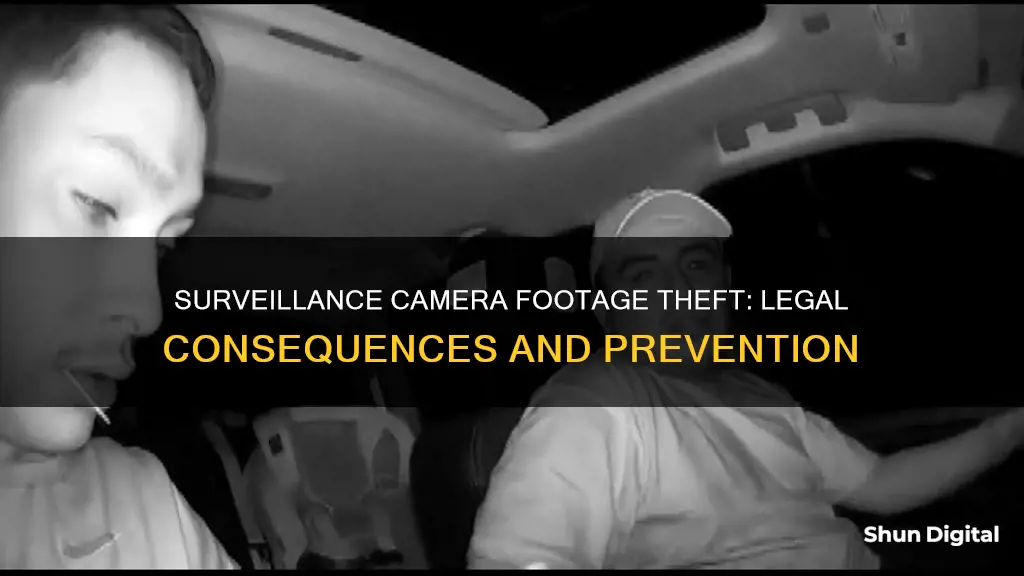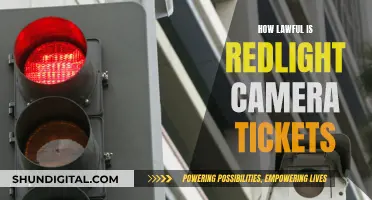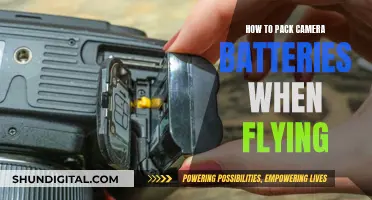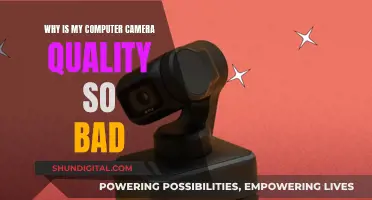
Surveillance camera footage is often used as evidence in criminal cases, so it's no surprise that thieves may try to steal the recording device to destroy any incriminating evidence. This can be frustrating for homeowners or businesses who have invested in security systems, as it may feel like the cameras have served no purpose if the footage is stolen. However, there are ways to protect against this. For example, some cameras have micro SD memory card slots, so even if the main storage unit is stolen, the footage remains on the SD card. Additionally, cloud storage is becoming an increasingly popular option for backing up surveillance footage, although it can be expensive and may reduce the clarity of the recordings.
| Characteristics | Values |
|---|---|
| Evidence | Lost |
| Recordings | Lost |
| Protection | Cloud cameras, micro SD memory cards, external hard drives, dummy cameras, decoy DVRs, NAS devices, locked rack/room |
What You'll Learn

Stealing the recorder means stealing evidence
To protect against this, some cameras have a micro SD memory card slot. This means that as the camera is streaming video to the video recorder, it is also streaming the video to the memory card in the camera. So, if someone breaks in and steals the video recorder, they have taken the main storage unit, but the footage of them breaking in and stealing the unit is still accessible.
There are other ways to protect against the theft of video recorders. One way is to use cloud cameras, which stream video to the cloud for recording. However, this method can result in reduced clarity and choppy viewing. Another way is to use a decoy DVR, where a dummy recorder is placed in plain sight, while the real one is hidden. A third option is to use IP cameras with on-board SD card recording, sending a second stream to the NVR. This means that if the NVR is stolen, the footage is still accessible from the camera, and if the camera is stolen, the footage is still accessible from the NVR.
Battery Exhausted: Quick Tips to Revive Your Camera
You may want to see also

Cloud cameras are a solution
The theft of surveillance camera footage is a serious concern for many businesses and individuals alike. In the event of a burglary, stealing the video recorder means the perpetrator also takes the evidence of their crime. Cloud cameras offer a modern and innovative solution to this problem.
Cloud cameras are a type of wireless security camera that transmits data to cloud-based storage systems, eliminating the need for bulky on-site storage equipment. This makes them ideal for those with limited space or those seeking a more streamlined security system. Cloud cameras are versatile and can be integrated into almost any location or environment, offering a flexible and scalable security solution.
One of the key advantages of cloud cameras is their ability to provide remote access to footage. This means that even if the physical recorder is stolen, the footage captured on it can still be accessed and downloaded from the cloud. This ensures that evidence of a break-in or theft is not lost, providing peace of mind and aiding in the investigation of such incidents.
Additionally, cloud-based security camera systems offer advanced features such as live video, night vision, two-way audio, and floodlight capabilities, enhancing the overall security of a premises. Cloud cameras also require less maintenance compared to traditional systems as updates can be installed over-the-air, freeing up time and resources for other IT operations.
While cloud cameras offer numerous benefits, it is important to consider potential drawbacks, such as bandwidth limitations. To manage this, cloud service providers may reduce the clarity of the footage or lower the frame rate, impacting the viewing experience. Additionally, cloud storage often comes with a monthly fee, which can be a consideration for cost-conscious individuals or businesses.
Overall, cloud cameras present a compelling solution to the issue of stolen surveillance camera footage, offering remote access, advanced features, and reduced maintenance requirements.
Troubleshooting Surveillance Camera Issues: A Comprehensive Guide
You may want to see also

Hard drives are a solid investment
Surveillance camera footage is vulnerable to theft and damage if stored on a physical video recorder. If someone steals the video recorder, they also take the evidence of them breaking in, along with the recordings.
To protect against theft, some people opt for cloud cameras, which stream video to a cloud server. However, this option has its drawbacks, including reduced video clarity and a monthly fee.
A more cost-effective solution is to use a hard drive to store surveillance footage. Hard drives are designed for continuous and demanding use, making them ideal for surveillance systems that require constant recording and monitoring. They have enhanced error recovery controls to prevent data corruption and ensure data integrity. They also have larger capacities than standard desktop drives, as video footage can take up a lot of space.
Reliability: Surveillance hard drives are built to withstand continuous operation, providing reliable performance and minimizing the risk of data loss. They are optimized for the write-intensive nature of surveillance footage, ensuring seamless video streaming and recording.
Durability: Surveillance hard drives are designed to be more durable than standard hard drives. They often feature vibration resistance, making them suitable for multiple cameras recording simultaneously.
Firmware Optimization: The firmware of surveillance hard drives is tailored to prioritize video streaming and recording performance, ensuring uninterrupted storage of critical footage.
Capacity: Surveillance hard drives come in larger capacities to accommodate the significant storage space required for video footage. This is especially important when storing high-resolution or 4K video files, which take up more space.
Energy Efficiency: Surveillance hard drives are designed to be energy-efficient and generate less heat to support 24/7 operation without compromising reliability.
Cost-Effectiveness: While cloud storage options may charge a monthly fee, investing in a hard drive is a one-time expense that provides long-term storage without ongoing costs.
In conclusion, hard drives offer a reliable, durable, and cost-effective solution for storing surveillance camera footage. They are designed to meet the demanding requirements of surveillance systems, ensuring the secure and uninterrupted storage of critical video data.
Camera Tickets: California's Lawful Surveillance
You may want to see also

Dummy cameras can be used as burglar bait
Dummy Cameras as Burglar Bait
Dummy cameras can be used as an effective burglar deterrent, but they can also be used as bait to lure burglars into a false sense of security. Here are some strategies to consider:
Obvious Fakes with Hidden Cameras
One approach is to install obvious dummy cameras in certain locations, leading the burglar to believe they are not being recorded. The trick is to let them think that there are no real cameras present. However, you can use hidden cameras to capture their face or other identifying details. To sell the illusion, ensure that the cables of the fake camera are visibly disconnected from the wall.
Double Camera Setup
Another tactic is to use a double camera setup, where you have two camera spots installed, but only one visible fake camera. The burglar might try to avoid the line of sight of the visible camera, but you can place a small-diameter hidden camera in a spot that a person would typically turn their face to avoid the first camera. This ensures that you capture their face or other identifying features.
Fake Cameras with Real Cameras
You can also use fake cameras to make your security setup appear more extensive than it is or to lure burglars into destroying the fake, only to be caught on a hidden real camera. This strategy might be considered overcomplicating things, as real cameras are affordable and easily accessible nowadays, making dummy cameras less effective.
Protecting Your Footage
If you're concerned about someone stealing your surveillance camera footage, consider using a micro SD memory card slot in the camera. This way, even if the video recorder is stolen, you still have the footage of the burglar breaking in and taking the unit. You can also back up your footage to the cloud, but be aware of potential issues with clarity, frame rate, and monthly fees.
Quickly Recover Deleted Camera Raw Files
You may want to see also

Lock and key solutions can be costly but effective
While surveillance cameras are an effective deterrent to criminal activity, thieves and vandals may attempt to steal, cover, or neutralize them. To protect your surveillance system and ensure its uninterrupted functionality, consider implementing lock and key solutions. Although these measures may be costly, they provide an added layer of security for your equipment and data.
One option is to use vandal-resistant housings for your cameras. These housings are made from robust, impact-resistant materials like heavy-duty metal or reinforced plastic. The IK rating scale is used to measure the level of protection provided by these housings, with IK10 indicating the highest level of protection against impacts. By using a housing with a high IK rating, you can make it more difficult for intruders to damage or tamper with your cameras.
Additionally, consider securing your cameras with locks and cables. Cable locks, such as the Master Lock Python, use a locking mechanism and cut-resistant cables to secure your equipment. This makes it harder for thieves to simply grab and run with your cameras.
Another lock and key solution is to use Torx Screws to mount your cameras. Torx Screws are an industry-leading attachment method that makes it extremely difficult for perpetrators to remove cameras from their mounts. This provides an extra layer of physical protection for your equipment.
To protect your data, consider using encryption. Encryption at Rest adds a layer of protection to all data stored on your security cameras. This means that even if a camera is stolen, the data will be inaccessible without the encryption keys. This provides an added level of security for sensitive footage.
While these lock and key solutions may require a significant investment, they offer increased protection for your surveillance equipment and data. By implementing these measures, you can make your surveillance system more robust and resilient against theft and vandalism.
Jamming Surveillance Cameras: DIY Guide to Privacy
You may want to see also
Frequently asked questions
If someone steals your video recorder, the footage will be lost along with the device. However, you can protect yourself by investing in a micro SD memory card that fits inside the camera. This way, if someone steals the recorder, you will still have the footage stored on the SD card.
There are several ways to protect your surveillance camera footage from theft. You can use cloud cameras to stream and record footage, although this may reduce the clarity of the recording and incur a monthly fee. Alternatively, you can use external storage solutions such as a hard drive or a NAS (Network-Attached Storage) device, which can be hidden in a locked box or an unexpected location.
You can use a combination of cloud storage and external storage solutions for redundancy. Additionally, you can physically protect your recorder by mounting it in a locked rack or room, or by bolting it down and using tamper-proof screws to secure the chassis.
In this case, having multiple cameras can help ensure that the thief is recorded on a different camera while they are tampering with one. You can also use cameras with SD card slots, so even if the camera is stolen, the footage will remain on the SD card.
You can place your camera inside your home, pointing outside. However, this may be limited by factors such as IR lamps, which can blind the camera. You can also use dummy cameras as bait and have your real cameras cover them. Mounting the camera in an inconvenient or out-of-reach spot can also make it more difficult for thieves to tamper with.







